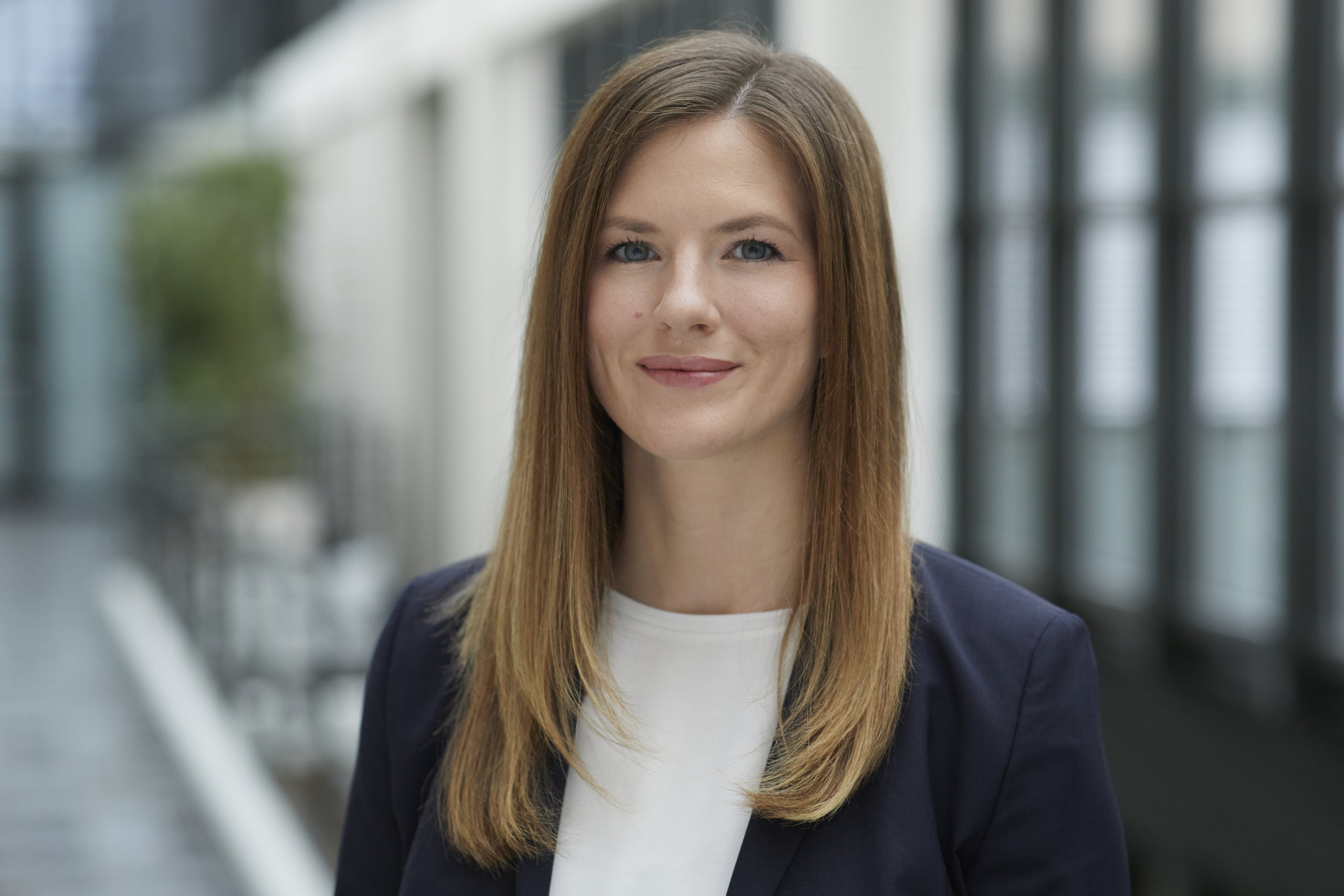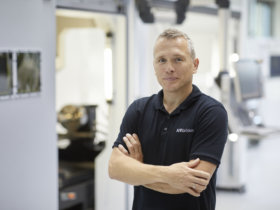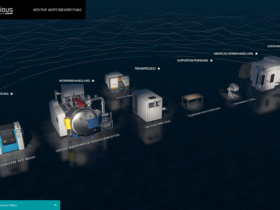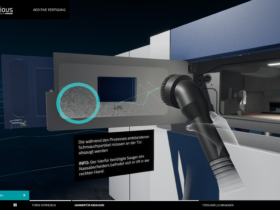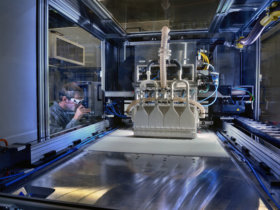3D printing – Ready for series production
The new claim of the VDW (German Machine Tool Builders’ Association) is “Innovate Manufacturing”. It is a clarion call to specialists all over the world to come to EMO Hannover from 18 to 23 September 2023. The World’s Leading Trade Fair for Production Technology aims to provide visitors with inspiring new ideas for innovating their manufacturing – including new 3D metal printing solutions for series production.
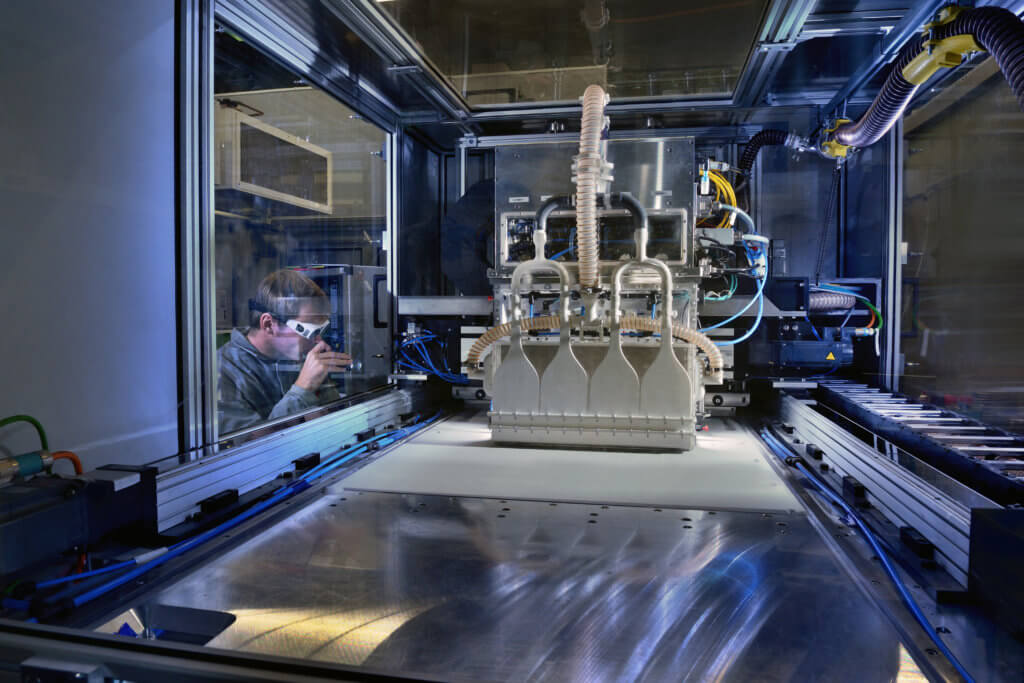
EMO Hannover 2023 – Two BMBF projects paving the way for additive manufacturing technology
Laser light flashes and creates a shiny silver circle in a gray powder bed. A skimmer brushes silently over the circle, which is now covered yet again with powder. And so the laser transforms layer after layer of powder into a shaped component of high complexity. However, at present it takes 25 hours to transform titanium powder into a hat-sized structure for use by the aviation industry.
Full-scale improvement accelerating metal printing
Anyone experiencing the 3D metal printing process for the first time is certain to be fascinated. Up to now, though, it has not only been the slow speed of the layering that stood in the way of series production, but also the lack of automation systems, digitalization strategies and customized metal powders.
The Fraunhofer Institute for Laser Technology ILT in Aachen established the laser-based powder bed fusion (LPBF) process more than a quarter of a century ago. The invention was patented back in 1996 and its current importance is also down to its constant further development since then. This has resulted in the creation of a prototype machine in Aachen whose productivity was significantly increased by multiplying the number of laser beams. The system can print very large components of up to 800 by 1,000 millimeters, and with a thickness of up to 350 millimeters. There have therefore been some significant developments in 3D metal printing in the meantime.
Basis for series production: Prototype prints Rolls-Royce turbine component
A YouTube video shows the prototype at work. The gantry system prints a 300 millimeter-high Rolls-Royce turbine component with a diameter of 620 millimeters from stainless steel. “We work ‘on-the-fly’. The process head moves while the lasers remelt the powder – practically eliminating all non-productive time,” explains Tim Lantzsch, head of the Process & Systems Engineering group at Fraunhofer ILT. “Cameras are used for process monitoring in order to visualize possible interactions between the laser beams and byproducts. You can see how stable and homogeneous the process is.”
The component was the focus of the virtual conference of the ICTM International Center for Turbomachinery Manufacturing Aachen in February 2022. But additive processes hold potential not only for aircraft engines and stationary turbomachinery for energy generation; the automotive industry is also strongly committed to the industrialization of 3D metal printing. The German Federal Ministry of Education and Research (BMBF) has also recognized this and launched the Idam project (Industrialization and Digitalization of Additive Manufacturing) in 2019. A project team spearheaded by the Munich-based BMW Group was formed with experts from small and medium-sized enterprises (SMEs), large corporations and research institutions. The common goal of the 12 project partners: to revolutionize metallic 3D printing in the field of automotive series production.
The Idam project was a success, as the BMW press office reported in May 2022: “We have succeeded in industrializing and digitalizing additive manufacturing (AM) for automotive production processes.” A digitally networked, fully automated 3D printing production line for automotive series production has been created at the BMW Group Additive Manufacturing Campus in Oberschleissheim. Another line is located at GKN Sinter Metals Engineering GmbH in Bonn. According to BMW, around 50,000 interchangeable and more than 10,000 individual and spare-part components can be manufactured cost-efficiently each year using the LPBF method. The recipe for success: the project participants have improved the entire process chain from the development and design of the 3D component, inline process monitoring and AI evaluation right to the digital twin.
The BMBF’s joint “Idea – Industrialization of Digital Engineering and Additive Manufacturing” project is a partnership-based collaboration between several companies from a wide range of industries. By the end of October 2022, the consortium leader Siemens Energy AG from Berlin, and Toolcraft AG, an SME from Georgensgmünd near Nuremberg, are set to have built two automated additive production lines for metal components to be used in turbomachinery and aerospace applications. They are intended to show that not only large corporations but also SMEs can enjoy economic success with the additive production of individualized products in small batches. The interdisciplinary project team, which brought together turbomachinery engineering, software, automation, aircraft technology, laser and 3D printing technology experts, has turned out to be a technology enabler.
Ready for series production despite strict safety rules
How does the Idea project differ from Idam? “In contrast to the BMBF’s Idam project, which focuses on automotive series production, Idea is all about turbomachinery and aerospace,” explains Thomas Laag, a research associate at Fraunhofer ILT. “Automotive production is set up for high unit numbers and short cycle times, whereas the unit numbers here are lower. In addition, these are larger components whose cycle times are not as short and precise as those in the automotive industry.” Added to this are the very high safety standards of the aerospace industry. For example, manufacturers of aerospace components must hold a Nadcap (National Aerospace and Defense Contractors Accreditation Program) certificate – the aerospace industry’s rigorous accreditation framework. Similar strict standards with regard to precision, for example, also apply to the production of power generation turbines.
Quality assurance has therefore played an important role in the project. “Two of our top priorities are process certification and powder condition monitoring,” says Laag. The laser powder bed fusion (LPBF) process is also used here, and for it the Fraunhofer ILT developed a pulsed laser radiation process control which improves the detail resolution and results in fewer shape deviations. It also reduces the amount of post-processing and enables new, more efficient component geometries.
Automated post-processing shortens production time
Another problem with additive processes such as laser powder bed fusion is component heating, which causes residual stresses and geometric component distortion. Support structures are used to dissipate the heat, but these then have to be removed manually in a time-consuming process. Further processing of 3D printed components therefore requires a large number of manual steps to compensate for geometric component distortion. It is also necessary to meet the extremely complex requirements of high-end industries, such as the aerospace sector, in terms of component specifications and the manufacturing process. These are typical challenges that are part of everyday life at toolcraft AG. The medium-sized company uses 3D metal printing for series production. It currently has 13 additive manufacturing systems in operation and works closely with well-known machine manufacturers.
But what impact did the BMBF Idea project have in Georgensgmünd? “We succeeded in incorporating the sub-processes more effectively in a complete manufacturing chain,” explains Markus Langer, Head of Technology and Development Programs at toolcraft. In addition, the automation of previously manual work steps increased the process stability and quality. Another key factor in Idea was the digitalization of work plans and work and inspection instructions. In combination with interactive training and VR goggles, this makes it easier for specialists in the metal-laser fusion center to work on highly complex machines and manufacturing processes.
But how is Germany performing internationally in terms of 3D metal printing? Can it compete with other countries? “Unfortunately, the pace of the industrialization of additive manufacturing in Germany is falling behind that of other industrialized nations such as China and the USA,” explains toolcraft CEO Christoph Hauck, regretfully. “These countries are pumping massive amounts of funding into the process, especially into its implementation in medium-sized companies. Unfortunately, Germany lost its leading position here quite some time ago.”
Dr.-Ing Jasmin Saewe, head of the Laser Powder Bed Fusion department at Fraunhofer ILT, is familiar with the international perspective from her involvement in many cross-border projects. Her views are clear: “Internationally, many countries are investing heavily in additive manufacturing and its industrialization right now. It is crucial that we in Germany do not simply rely on our long-held pioneering position in additive manufacturing. Instead we must continue researching into raising productivity and redouble our efforts to put the technology to industrial use in order to help industry face challenges such as supply bottlenecks.”
((Length: around 9,500 characters including spaces))
Author: Nikolaus Fecht, specialist journalist, Gelsenkirchen
((info box))
Additive manufacturing at EMO Hannover
Generative manufacturing processes are playing an increasingly important role in industrial production and are therefore firmly established at EMO Hannover. This is also reflected in the figures from the 2019 visitor survey: around 16 percent said they were interested in offerings from this sector. On the exhibitor side, numerous companies presented machines, systems, components and materials for additive manufacturing or services from this sector – including as part of the “additive manufacturing circle” concept with a joint stand, expert talks and much more. Thus, trade visitors can also look forward to a large number of new highlights in the coming year.
Background
EMO Hannover 2023 – World’s Leading Trade Fair for Production Technology
International manufacturers of production technology will be presenting smart technologies for the entire value chain at EMO Hannover 2023 from 18 to 23 September 2023. Under the banner of Innovate Manufacturing, the world’s leading trade fair for production technology will showcase the entire range of modern metalworking technology which is at the heart of every industrial production process. The latest equipment will be on display, as will efficient technical solutions, product-related services, sustainable production methods and much more besides. The main focus of EMO Hannover is on cutting and forming machine tools, manufacturing systems, precision tools, automated material handling, computer technology, industrial electronics and accessories. EMO visitors come from all major industrial sectors including machine and plant construction, the automotive industry and parts suppliers, aerospace technologies, precision engineering and optics, shipbuilding, medical engineering, tool and mold making, steel and lightweight construction. EMO Hannover is the number one international meeting place for the industry. More than 2,200 exhibitors from 47 countries attracted nearly 120,000 trade visitors from around 150 countries at EMO Hannover 2019. EMO is a registered trademark of the European machine tool association Cecimo. EMO is organized by the VDW (German Machine Tool Builders’ Association), Frankfurt am Main, Germany.
You can also visit the EMO via our social media channels
Downloads
Documents
Pictures
Picture 1: Dr.-Ing. Jasmin Saewe, Head of Laser Powder Bed Fusion Department at Fraunhofer ILT: “Internationally, many countries are investing heavily in additive manufacturing and its industrialization right now.” Source: Fraunhofer ILT
Picture 2: Christoph Hauck, director, toolcraft AG: “Unfortunately, the pace of the industrialization of additive manufacturing in Germany is falling behind that of other industrialized nations such as China and the USA.” Source: toolcraft
Picture 3: Markus Langer, Head of Technology and Development Programs at toolcraft: We succeeded in incorporating the sub-processes more effectively in a complete manufacturing chain.” Source: toolcraft
Picture 4: In the BMBF project IDEA, the automation of previously manual work steps increased process stability and quality. Source: toolcraft
Picture 5: In combination with interactive training and VR goggles, the digitalization of work and inspection instructions makes it easier for specialists to work on highly complex machines and manufacturing processes. Source: toolcraft
Picture 6: The Fraunhofer ILT established the laser-based powder bed fusion (LPBF) process more than a quarter of a century ago. The picture shows a prototype machine whose productivity was significantly increased by multiplying the number of laser beams. Source: Fraunhofer ILT


